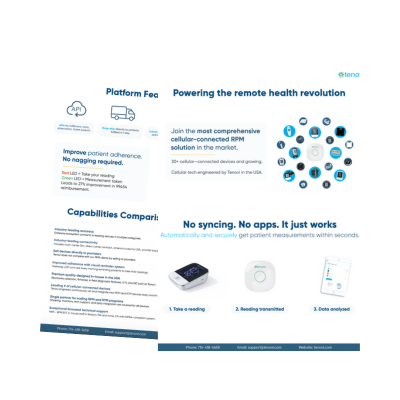People at high risk for stroke and stroke survivors can help prevent a first or repeat stroke with vital signs monitoring. Remote patient monitoring (RPM) technology enables patients to track vital signs from home. With RPM, tracked data is transmitted in real-time to the patient’s medical team via cellular or Bluetooth RPM devices, such as blood pressure monitors and blood glucose meters.
This steady stream of data allows physicians to detect strokes and intervene. According to research from the American Heart Association, RPM leads to substantially greater reductions in blood pressure compared to usual care and self-monitoring alone. When RPM is combined with telehealth for stroke programs, it can further help patients pursue lifestyle changes.
Let’s explore how RPM can improve outcomes or prevent recurrent or first-time strokes altogether.
Why Stroke Vital Signs Monitoring is Necessary
The AHA reports nearly 795,000 strokes occur each year. About 610,000 of those are first-time strokes. Hypertension and diabetes are two major risk factors for stroke. Fortunately, both can be minimized by eating healthier, avoiding stress, and exercising more. It is estimated that about 80% of strokes are preventable.
Making lifestyle changes can be challenging. Patients may need support adhering to long-term treatment plans. Including consistent stroke vital sign tracking like daily blood pressure and blood glucose level measurements can help. Patients who stick to an RPM measurement schedule become aware of their everyday health. This encourages healthier lifestyles that significantly reduce stroke risk. Some RPM companies, such as Tenovi provide simple visual measurement reminders for seniors so they don’t have to use an app or pair devices.
What is Remote Patient Monitoring?
Remote patient monitoring devices transmit patient physiological data in real-time to their clinician for review. Physicians can review data such as a patient’s heart rate, weight, oxygen saturation, pulse rate, glucose levels, and more. Providers can choose from a growing list of FDA-cleared remote patient monitoring devices and software services according to their patient needs.
Remote patient monitoring provides accurate patient health data for clinicians to maximize care. For example, RPM focuses on preventative care by allowing clinicians to monitor patients between visits and quickly intervene when necessary. In addition, Medicare reimburses healthcare providers for monitoring stroke vital signs because it is an effective way to help manage chronic conditions. For providers to receive reimbursement, patients must take their vital signs measurements at least 16 days a month.
With RPM, physicians can check how patients respond to treatments, adjust prescriptions, and schedule in-person appointments before complications worsen and require a costly trip to the emergency room. When patients know a physician monitors their daily health, they are often more careful with adhering to treatment plans. The increased care supports patients at all stages of stroke prevention management.
As mentioned, stroke vital signs monitoring consists of measuring blood pressure and blood glucose for early detection and control of two major risk factors for stroke: hypertension and diabetes. The following sections describe how remote blood pressure and glucose monitoring aids stroke prevention.
Remote Blood Pressure Monitoring for Stroke
High blood pressure is the most controllable risk factor for stroke. It’s also the leading cause of stroke. High blood pressure puts extra pressure on blood vessels. Over time, a blood vessel may be unable to withstand the pressure and rupture, causing a hemorrhagic stroke.
High blood pressure can also cause artery walls to thicken, narrowing the space available for blood to pass and increasing the chances of blockage that can cause ischemic stroke. Additionally, particles of damaged arteries can be swept off by high blood pressure and caught in smaller blood vessels.
With RPM and stroke vital signs monitoring, qualified healthcare professionals can set a threshold to receive real-time alerts if a patient’s blood pressure reading is too high. Patients should aim for a blood pressure reading of less than 130/80 mmHg. Anything above this is considered hypertensive and increases the risk of stroke. Clinicians can use RPM to monitor trends in blood pressure readings, observe how patients respond to medications, and adjust accordingly.
Remote Blood Glucose Monitoring for Stroke
Diabetes is a significant risk factor for stroke. In the United States, diabetes is the seventh leading cause of death. Moreover, 65% of those deaths are attributable to cardiovascular disease or stroke. With diabetes, glucose is not adequately absorbed, so it remains in the blood and damages blood vessels. High blood glucose levels also cause the arteries to stiffen and narrow, increasing the risk of blockage.
It’s suggested that a stroke that occurs with high blood glucose levels results in greater brain damage. Patients should aim for a blood glucose reading between 80-130 mg/dL before a meal and below 160 mg/dL two hours after a meal. Regular blood glucose monitoring allows patients to be more informed and involved in stroke prevention.
Fortunately, diabetes can be tracked and managed through remote blood glucose monitoring. When patients take their vital signs consistently, they understand how diet, physical activity, medications, and stress affect their blood glucose levels. In addition, with stroke vital signs monitoring data, healthcare providers gain insights into short-term and long-term patient vital trends.
Stroke and Vital Signs Monitoring Research
A Mass General Brigham study found that treating high blood pressure and cholesterol with RPM reduced stroke and heart disease risk. The 10,803 patients in the RPM program used home blood pressure monitoring with pharmacist-led medication management. Analysis of over 400,000 home blood pressure readings showed significant decreases in blood pressure compared to office readings.
Importantly, blood pressure improvement was consistent across demographic groups with higher hypertension risk. In contrast, patients who received only educational materials without medication titration did not experience gradual blood pressure changes. Overall, the findings demonstrate that RPM tools like home blood pressure monitoring can effectively improve hypertension control. In addition, remote patient care is also being used to optimize post-stroke brain health.
How to Avoid Stroke with Vital Signs Monitoring
Why are vital signs monitoring necessary? Monitoring vital signs to prevent stroke allows patients to see daily trends and better understand the long-term need to adopt healthy behaviors. Remote patient monitoring companies can help expand healthcare beyond the clinic and into patients’ everyday lives.
Through RPM, patients at high risk for hypertension, diabetes, or both can significantly reduce their risk of stroke. Similarly, clinicians can better understand their patient’s specific cardiovascular conditions and focus on preventative care over reactive care.
Tenovi works exclusively with companies that would like to offer remote patient monitoring solutions to healthcare providers. Are you an RPM software and services company, chronic management organization, or telehealth company interested in trying our platform? Contact us for a free consultation and demo.


